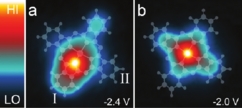We exploit several scanning tunneling microscopy (STM) techniques, such as atom manipulated scans and constant-height scans, to atomically resolve the adsorption geometry of isolated cobalt-phthalocyanine (CoPc) molecules on a copper (111) surface and to obtain proper low-temperature maps of the molecular conductance. By comparing these crucial findings to density functional calculations, we then provide fresh insight into the CoPc-metal interface. This innovative STM study should be applicable to a wide variety of molecules relevant for molecular electronics.

We exploit several scanning tunneling microscopy (STM) techniques, such as atom manipulated scans and constant-height scans, to atomically resolve the adsorption geometry of isolated cobalt-phthalocyanine (CoPc) molecules on a copper (111) surface and to obtain proper low-temperature maps of the molecular conductance. By comparing these crucial findings to density functional calculations, we then provide fresh insight into the CoPc-metal interface. This innovative STM study should be applicable to a wide variety of molecules relevant for molecular electronics.
